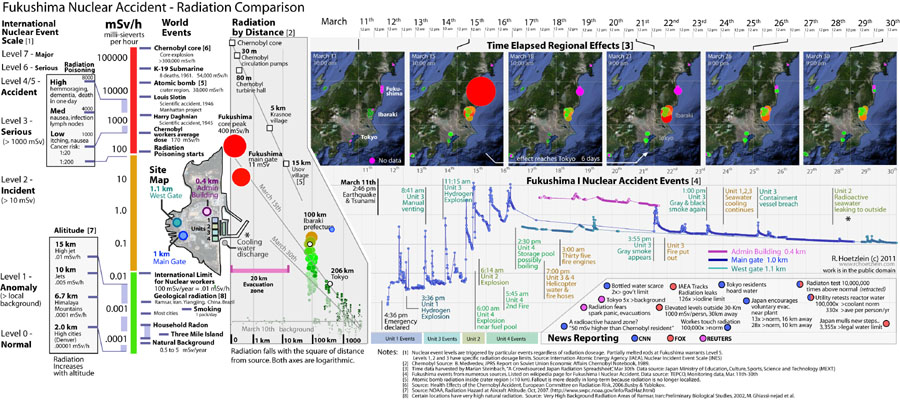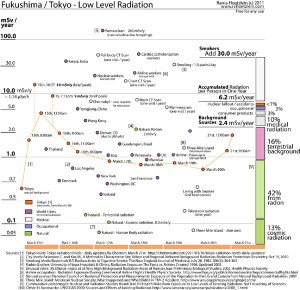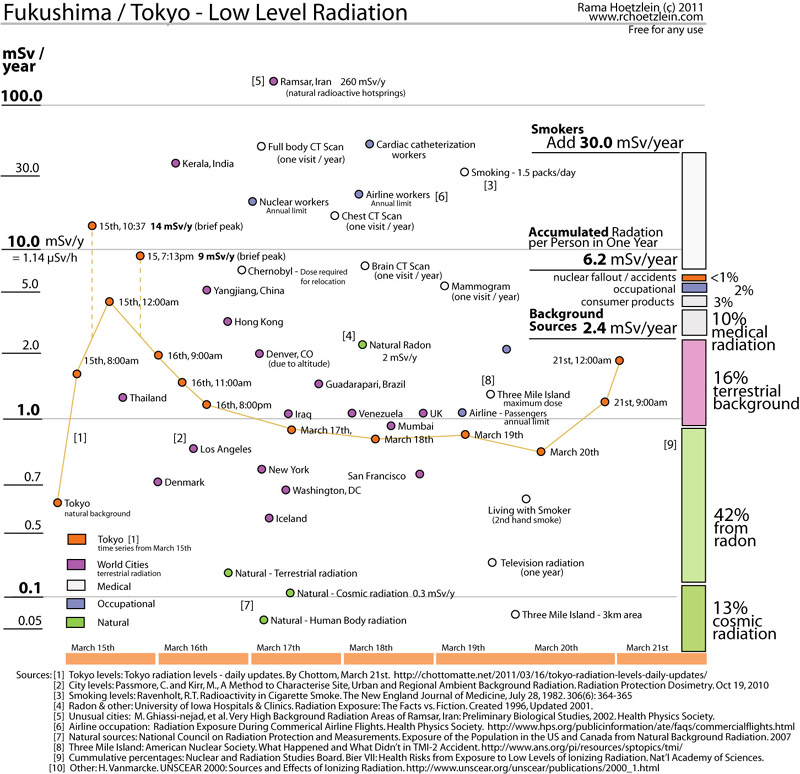This new video shows an animated information graphic of regional effects of Fukushima radiation from March 8th to 31st, 2011.
The first section shows particulate radiation reaching Ibaraki Prefecture and Tokyo by atmospheric dispersion. Time to reach Tokyo is delayed by roughly six days. Purple indicates a data outage. The second part shows how radiation levels in Ibaraki Prefecture, 128 km away from Fukushima, silently pass over the town in waves of radiation significantly higher than normal. The third part plots radiation versus distance, in which radiation from particulate matter is significantly less at various distances from Fukushima. While ionizing radiation is known to fall with the square of distance (linear in a log plot), this part shows that particulate radiation also falls off rapidly with distance due to atmospheric scattering, although in a more complex way depending on local weather.
Category: World Events
* Note: I’m pleased to announce a new animated graphic of Fukushima radiation regional effects. Click here.
Click for detailed image.
Recent concerns with the Fukushima incident focus on levels of radiation reaching Tokyo.
Are the level of radiation high enough to warrant evacuation in Tokyo?
This scatter plot shows the levels of radiation recorded by Geiger-counter in Tokyo over the past 7 days. All units are in mSv/year. These values are compared with terrestrial background radiation in other cities in the world. Note, for example, that some cities such as Yiangjing, China emit 5.0 mSv/year naturally. Certain unique places such as Ramsar, Iran emit 260 mSv/year due to natural radioactive hotsprings. Denver, Colorado emits 2.0 mSv/year due to its high altitude. During the Fukushima incident, Tokyo measurements are between 0.3 mSv/y and 2.6 mSv/year.
Also shown are radiation levels due to cosmic background, radon, and medical uses. Radiation is cummulative, and the average annual radiation per person in the US is 6.4 mSv/year. 42% of this radiation comes from natural radon in the air. 10% comes from medical radiation. Typically, a single visit for a Chest X-ray, or CT Scan can provide the total budget of medical radiation for a whole year. CT Scans are considerably more radiant, giving off 18 mSv/dose for a Chest CT, and 40 mSv/dose for a Full body CT, whereas a normal X-ray is 0.06 mSv/dose. Smoking is a major contributor to annual radiation, adding 30 mSv/year when smoking 1.5 packs per day. This is significantly above the 6.4 mSv/year typically received for one per person. A television emits slightly above the natural background radiation.
The result of these findings is that direct radiation emitted from Fukushima presents no cause for concern. Its only been 7 days. A level of at least 10 mSv/year would need to be sustained — for the whole year — to make it a significant contribution to our annual radiation intake. Values in Tokyo currently average around what is typical in Denver, Colorado. Hence, elevated concern due to direct radiation is not warranted at this time.
However, another source of radiation in Tokyo is potential radioactive material, rather than direct radiation. Direct radiation coming from Fukushima falls off as the inverse square of distance, and can be measured by geiger-counter, which is shown in this plot. On the other hand, radioactive particles may be carried in the air and transported to Tokyo, and must be measured differently. Transported particles, suspended in air and carried by weather, could cause much higher radiation to occur directly in Tokyo. At present, I do not know of any direct particulate measurement data being taken in Tokyo.
Another possible source is the transport of larger particles by land. These could come from contaminated foods or from particles lodged in clothing from evacuees around Fukushima. So far, these levels are not high enough to warrant concern. Overall, one should be very wary of any media claims based on increased Geiger-counter measurements in Tokyo, while recordings of particulate radiation would be much more useful. The question we should be trying to answer is not, “How much radiation is there in Tokyo?”, the question should be: How much transported radioactive material is there in Tokyo?
It is important to note that other health factors are of much greater concern at these low radiation levels. For the average person, natural risks of cancer due to other factors such as genetics, risks associated with bad eating habits, or lack of exercise, are much more significant than those caused by these low levels of radiation. The only outstanding exception is smoking, as cigarettes contain lead and polonium which emit radioactive radiation while smoking. The cancer risks associated with smoking are 1 in 200, fours times higher than average. There are 1.7 million deaths caused by lung cancer in the world annual, and 91% of these are due to smoking.
Source material:
[1] Tokyo levels: Tokyo radiation levels – daily updates. Geiger counter readings by Chottom, March 21st. http://chottomatte.net/2011/03/16/tokyo-radiation-levels-daily-updates/
Alternatively, you can find up date radiation levels across Japan here.
[2] ] City levels: Passmore, C. and Kirr, M., A Method to Characterize Site, Urban and Regional Ambient Background Radiation. Radiation Protection Dosimetry. Oct 19, 2010
[3] Smoking levels: Ravenholt, R.T. Radioactivity in Cigarette Smoke. The New England Journal of Medicine, July 28, 1982. 306(6): 364-365
[4] Radon & other: University of Iowa Hospitals & Clinics. Radiation Exposure: The Facts vs. Fiction. Created 1996, Updated 2001.
[5] Unusual cities: M. Ghiassi-nejad, et al. Very High Background Radiation Areas of Ramsar, Iran: Preliminary Biological Studies, 2002. Health Physics Society.
[6] Airline occupation: Radiation Exposure During Commercial Airline Flights. Health Physics Society. http://www.hps.org/publicinformation/ate/faqs/commercialflights.html
[7] Natural sources: National Council on Radiation Protection and Measurements. Exposure of the Population in the US and Canada from Natural Background Radiation. 2007
[8] Three Mile Island: American Nuclear Society. What Happened and What Didn’t in TMI-2 Accident. http://www.ans.org/pi/resources/sptopics/tmi/
[9] Cumulative percentages: Nuclear and Radiation Studies Board. Bier VII: Health Risks from Exposure to Low Levels of Ionizing Radiation. Nat’l Academy of Sciences.
[10] Other source: H. Vanmarcke. UNSCEAR 2000: Sources and Effects of Ionizing Radiation. http://www.unscear.org/unscear/publications/2000_1.html
FUKUSHIMA NUCLEAR RADIATION MAP
2012, Rama Hoetzlein

| 2012. Hoetzlein, R. Visual Communication in Times of Crisis: The Fukushima Nuclear Accident. Leonardo Journal of Arts, Science and Technology. Volume 45, Number 2, pp 113-118. April 2012. |
Abstract
The Fukushima Radiation Comparison Map shows several aspects of the 2011 Fukushima nuclear disaster during the first few weeks that events unfolded. Based on radiation data available from MEXT (Ministry of Education, Culture, Sports, Science and Technology in Japan), the map shows radiation levels at the site during a two week period from March 11th to March 30th, 2011. Key accident events are mapped with correlation to live radiation data (bottom right). Comparisons to other major historic nuclear accidents are all mapped according to common scale in mSv/h, millisieverts per hour (left side).
Ibaraki Prefecture Animation
This work follows the development of visual communication through information visualization in the wake of the Fukushima nuclear accident in Japan. While information aesthetics are often applied to large data sets retrospectively, the author developed new works concurrently with an ongoing crisis to examine the impact and social aspects of visual communication while events continued to unfold. The resulting work, Fukushima Nculear Accident – Radiation Comparison Map, is a reflection of rapidly acquired data, collaborative on-line analysis and reflective criticism of contemporary news media, resolved into a coherent picture through the participation of an on-line community.
Tokyo Low-Level Radiation
This scatter plot shows the levels of radiation recorded by Geiger-counter in Tokyo over 7 days from March 15th to 21st. These values are compared with terrestrial background radiation in other cities in the world. Note, for example, that some cities such as Yiangjing, China emit 5.0 mSv/year naturally. Certain unique places such as Ramsar, Iran emit 260 mSv/year due to natural radioactive hotsprings. Also shown are radiation levels due to cosmic background, radon, and medical uses. Radiation is cummulative, and the average annual radiation per person in the US is 6.4 mSv/year. 42% of this radiation comes from natural radon in the air. 10% comes from medical radiation. Typically, a single visit for a Chest X-ray, or CT Scan can provide the total budget of medical radiation for a whole year. CT Scans are considerably more radiant, giving off 18 mSv/dose for a Chest CT, and 40 mSv/dose for a Full body CT, whereas a normal X-ray is 0.06 mSv/dose. Smoking is a major contributor to annual radiation, adding 30 mSv/year when smoking 1.5 packs per day. This is significantly above the 6.4 mSv/year typically received for one per person. A television emits slightly above the natural background radiation.
The result of these findings is that direct radiation emitted from Fukushima presented no cause for concern. A level of at least 10 mSv/year would need to be sustained — for the whole year — to make it a significant contribution to our annual radiation intake. Values in Tokyo currently average around what is typical in Denver, Colorado. Hence, elevated concern due to direct radiation is not warranted at this time.
The maps above examine direct electromagnetic radiation and particulate scattering in the air during the time of the events in 2011. They do not address consumption of radioactive particles by fish and animals, absorption by soil, and dispersion of radioactive waste water in the Pacific ocean. These later processes may contribution much more significantly to the long term effects of the Fukushima accident.


